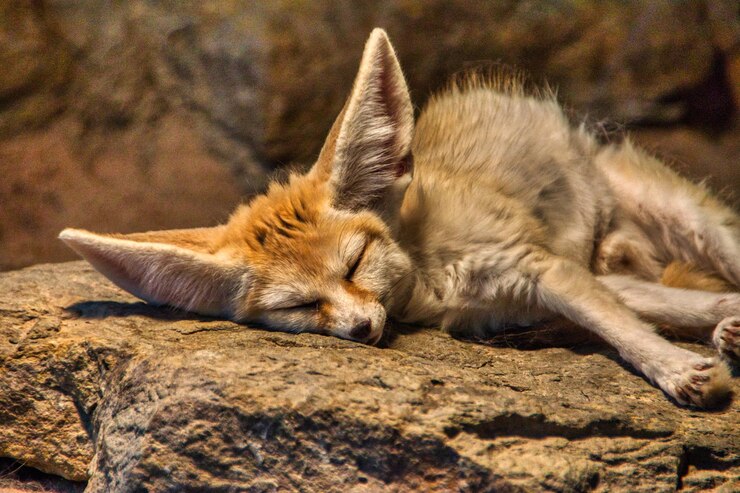The Sahara’s sands hold many secrets, and among them scurries a creature with oversized charm – the fennec fox. These pint-sized foxes, with their comically large ears and mischievous eyes, have captivated hearts worldwide. But beyond their adorable appearance lies a fascinating story of adaptation, resilience, and social dynamics. So, prepare to delve into the desert world of the fennec fox as we explore their diet, habitat, and some truly fun facts!
Desert Delights: What’s on the Fennec Fox’s Menu?

While their desert home might seem barren, fennec foxes are resourceful omnivores, finding sustenance in unexpected places. Their diet is a diverse mix of:
- Small prey: Rodents, insects (especially grasshoppers and locusts), lizards, and birds make up the meat portion of their meals. Their incredible hearing helps them pinpoint even underground prey, making them efficient hunters.
- Fruits and vegetables: Dates, berries, and various desert plants contribute essential vitamins and moisture. Their diet adapts to seasonal availability, ensuring they thrive year-round.
- Eggs: These protein-rich snacks are a valuable source of nourishment, especially for growing pups.
Water Wizards: Despite the scorching heat, fennec foxes have ingenious ways to stay hydrated. They obtain most moisture from their food, needing minimal water intake. Additionally, their kidneys are adapted to conserve water, making them masters of desert survival.
A Home Fit for Tiny Royalty: Fennec Fox Habitats

Imagine a vast canvas of sand dunes, punctuated by sparse vegetation. This is the fennec fox’s kingdom, stretching across the Sahara and parts of North Africa and the Arabian Peninsula. They favor:
- Stable sand dunes: These provide the perfect ground for digging intricate burrow systems, with multiple chambers for sleeping, raising young, and escaping the midday sun.
- Vegetated areas: Nearby scrubland or scattered plants offer shade, additional food sources, and protection from predators.
Social Butterflies of the Desert: Unlike most foxes, fennec foxes are highly social creatures. They live in family groups of up to 10 individuals, with complex social structures and communication systems. Their dens become bustling hubs of activity, filled with playful pups, vigilant parents, and cooperative hunters.
Fennec Fun Facts: Unveiling the Fox’s Secrets

- Big Ears for Big Reasons: Those oversized ears aren’t just for show. They radiate heat, helping the fox regulate its body temperature in the scorching desert. Additionally, their excellent hearing aids in prey detection and communication with their social group.
- Silent Scamperers: Fennec foxes have fur-covered paws that act as silent cushions, allowing them to move stealthily across the sand, surprising their prey and evading predators.
- Leap of Faith: Despite their small size, fennec foxes can jump impressive distances, up to 4 feet high and 12 feet forward! This agility helps them navigate their dune-filled habitat and capture elusive prey.
- Scentsational Secrets: Like other foxes, fennec foxes communicate through scent marking. They use urine and glands to mark their territory, warn off rivals, and attract mates.
- Family First: Both parents contribute to raising pups, from providing food to teaching hunting skills. The young ones stay with the family for up to a year, learning the ways of the desert before venturing out on their own.
- Desert Dentists: Fennec foxes have remarkably strong teeth, adapted to crunching through bones and insects with ease. Their dental health is crucial for their survival in the harsh desert environment.
- Moonlight Mysteries: These foxes are primarily nocturnal, emerging at dusk and dawn to avoid the daytime heat. Their large eyes provide excellent night vision, allowing them to hunt effectively under the starry sky.
- Ancient Ancestors: The fossil record suggests fennec foxes have been around for over 5 million years, evolving to thrive in the ever-changing desert landscape.
- Vulnerable Charmers: Despite their captivating appearance, fennec foxes face threats like habitat loss and illegal pet trade. Conservation efforts are underway to protect these desert wonders.
- Not Just Cute: While undeniably adorable, fennec foxes are not ideal pets. Their complex social needs and specialized diet make it challenging to provide proper care in captivity.
A Final Note: Appreciating the Fennec Fox
The fennec fox is a remarkable creature, a testament to evolution’s ingenuity and the beauty of desert life. By understanding their diet, habitat, and fascinating facts, we can appreciate them not just for their cuteness but also for their resilience and unique role in the ecosystem. Let’s work together to ensure these desert charmers continue to thrive for generations to come.

